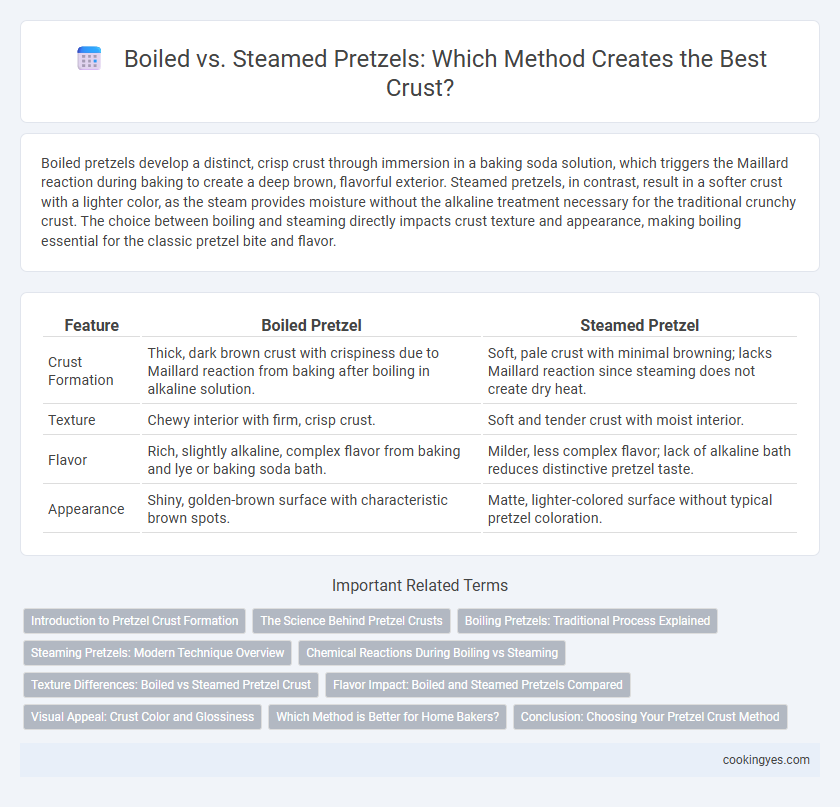Boiled pretzels develop a distinct, crisp crust through immersion in a baking soda solution, which triggers the Maillard reaction during baking to create a deep brown, flavorful exterior. Steamed pretzels, in contrast, result in a softer crust with a lighter color, as the steam provides moisture without the alkaline treatment necessary for the traditional crunchy crust. The choice between boiling and steaming directly impacts crust texture and appearance, making boiling essential for the classic pretzel bite and flavor.
Table of Comparison
| Feature | Boiled Pretzel | Steamed Pretzel |
|---|---|---|
| Crust Formation | Thick, dark brown crust with crispiness due to Maillard reaction from baking after boiling in alkaline solution. | Soft, pale crust with minimal browning; lacks Maillard reaction since steaming does not create dry heat. |
| Texture | Chewy interior with firm, crisp crust. | Soft and tender crust with moist interior. |
| Flavor | Rich, slightly alkaline, complex flavor from baking and lye or baking soda bath. | Milder, less complex flavor; lack of alkaline bath reduces distinctive pretzel taste. |
| Appearance | Shiny, golden-brown surface with characteristic brown spots. | Matte, lighter-colored surface without typical pretzel coloration. |
Introduction to Pretzel Crust Formation
Pretzel crust formation is influenced by the cooking method, with boiled pretzels developing a unique, chewy crust through the Maillard reaction triggered by alkaline water immersion. Steamed pretzels, however, produce a softer crust due to moisture retention and lack of surface alkalinity. Boiling in a baking soda solution enhances the characteristic brown color and distinctive flavor that define traditional pretzels.
The Science Behind Pretzel Crusts
Boiled pretzels develop a distinctive crust through the Maillard reaction, initiated by the alkaline bath of baking soda or lye that raises surface pH and accelerates browning during baking. Steamed pretzels, conversely, retain more moisture on the surface, resulting in a softer, less chewy crust due to reduced Maillard reaction intensity. The chemical environment created by boiling enhances caramelization and flavor complexity, whereas steaming preserves a lighter texture with diminished crust formation.
Boiling Pretzels: Traditional Process Explained
Boiling pretzels in a baking soda solution creates a distinctive chewy crust by gelatinizing the starch on the surface, which is essential for the classic pretzel texture. This traditional boiling process induces the Maillard reaction during baking, resulting in the characteristic deep brown color and rich flavor. Steaming pretzels, in contrast, produces a softer crust but lacks the signature chewiness and golden crust developed through boiling.
Steaming Pretzels: Modern Technique Overview
Steaming pretzels creates a distinct crust by introducing moisture that gelatinizes the surface starches, resulting in a softer, less shiny exterior compared to the traditional boiled method. This modern technique preserves the pretzel's chewiness while allowing for more uniform browning during baking. Unlike boiling, steaming enables vendors to infuse subtle flavors and maintain consistent crust texture, meeting contemporary consumer preferences for artisanal bread products.
Chemical Reactions During Boiling vs Steaming
Boiled pretzels undergo the Maillard reaction due to the alkaline bath, typically lye or baking soda, which promotes browning and develops a firm, chewy crust by reacting amino acids and reducing sugars on the dough surface. In contrast, steamed pretzels primarily retain moisture without triggering significant Maillard browning, resulting in a softer, less crisp crust due to the lower temperatures and absence of alkaline conditions. The boiling process enhances caramelization and crust texture, whereas steaming limits chemical reactions, favoring a softer pretzel.
Texture Differences: Boiled vs Steamed Pretzel Crust
Boiled pretzels develop a dense and chewy crust due to the Maillard reaction triggered by the alkaline water bath, creating a signature deep brown color and slightly crisp exterior. Steamed pretzels result in a softer, less chewy crust with a pale appearance, as steam lacks the chemical interaction needed for crust caramelization. Texture differences highlight boiled pretzels as having a firmer, more resilient bite, while steamed pretzels offer a tender, bread-like softness.
Flavor Impact: Boiled and Steamed Pretzels Compared
Boiled pretzels develop a distinctive, chewy crust with a deep mahogany color due to the Maillard reaction triggered by alkaline water, enhancing their signature savory flavor. Steamed pretzels tend to have a softer, pale crust with a milder taste and less caramelization, resulting in a less intense flavor profile. The boiling process intensifies the characteristic pretzel flavor through crust formation, while steaming produces a subtler, bread-like taste.
Visual Appeal: Crust Color and Glossiness
Boiled pretzels develop a deep brown crust with a glossy sheen due to the Maillard reaction triggered by the alkaline water bath, creating a visually appealing, shiny surface. Steamed pretzels exhibit a lighter, matte crust lacking the characteristic golden-brown hue and glossiness, resulting in a less striking appearance. The distinctive dark color and glossy finish of boiled pretzels significantly enhance their visual appeal compared to steamed variations.
Which Method is Better for Home Bakers?
Boiled pretzels develop a thicker, chewier crust due to the Maillard reaction triggered by the alkaline water bath, offering a classic texture favored by traditionalists. Steamed pretzels produce a softer, less browned crust, which may appeal to those seeking fluffier results but lack the signature chewiness. For home bakers aiming for authentic crust formation, boiling is generally better, as it ensures a well-defined crust and enhanced flavor.
Conclusion: Choosing Your Pretzel Crust Method
Boiled pretzels develop a characteristic thick, chewy crust with a deep brown color due to the Maillard reaction facilitated by the alkaline lye or baking soda bath. Steamed pretzels result in a softer, less crispy crust with a lighter color, as steaming introduces moisture without the chemical crust hardening effect. Opt for boiling when a traditional crust with crunch and rich flavor is desired, while steaming suits those preferring a tender, softer pretzel texture.
Boiled pretzel vs steamed pretzel for crust formation Infographic

 cookingyes.com
cookingyes.com